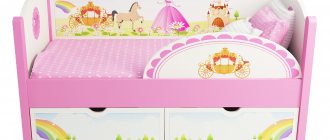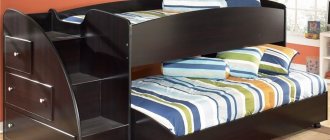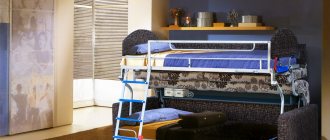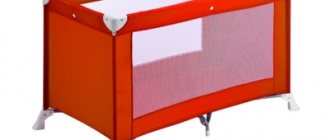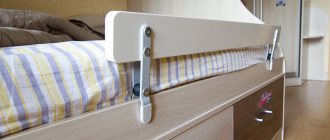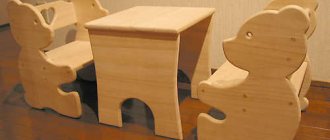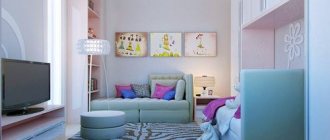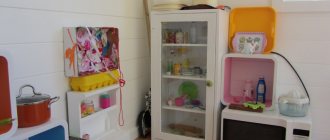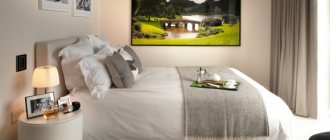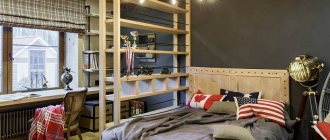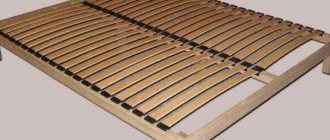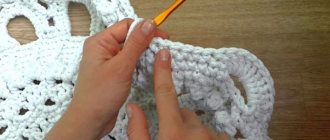Zoning
The space for the child can be organized in a separate room or inside the living room or bedroom. The first option is better than the second, because... it allows you to easily “unite” four zones in one place:
- workplace (represents a children's wall with a tabletop or a separate table with a chair/stool);
- play area (suggests setting up a children's playhouse, wall bars, play mat or bright, wear-resistant rug);
- a place to rest (depending on the number and age of children, it may look like a single, bunk or pull-out bed);
- storage area (provides open floor modules, a rack, a niche, organizer covers, etc.).
It doesn’t matter if you have to live in a studio apartment or a two-room apartment: firstly, experienced designers have developed many thematic solutions for arranging a children’s room inside an adult room; secondly, the corresponding principle has one good advantage - the child is always in sight . But over time, of course, we must try to allocate a separate area for it. Moreover, the organization of the nursery itself largely depends on the child’s age.
Age 0-3 years. This nursery can be left practically empty: all you need is a crib for a newborn, a high chair, a rug for outdoor fun, decor and curtains that will protect daytime sleep from sunlight. Thus, it was found that the main attention is paid to the sleeping area.
Age 3-7 years. The child grows and moves, so it is very important to encourage early physical activity by improving the play area. And this is despite the preschool program (the child will still have time to learn, because he cannot escape the new work area).
Age 7-12 years. During this period, hyperactivity is noted, but this does not mean that the child should be pampered with toys, bright colors, etc. Efforts will have to be directed to the development of the mind: the study and creativity zone should become the main one, everything in the interior should be orderly.
Here are a few ways to help divide a room into zones :
- installation of partitions (cladding can be gypsum board, fiberglass, lining);
- installation of furniture according to plan (this method is well suited for arranging in the “room within a room” style);
- pasting the walls with wallpaper of different styles (if the work area is usually kept in strict neutral colors, then the play area is in bright and multi-colored colors);
- organization of lighting of different powers (for rest - low light, for games - strong light).
Design options
The variety of bed-house models increases significantly when constructive ideas are complemented by stylistic ones:
- For babies, young princesses and girls, the designers have prepared compositions in pastel colors, with a canopy or lace. The design is dominated by pink, lemon, and beige shades. Such bed-houses, in addition to their direct purpose, perform a decorative function. To prevent the design from looking too bulky, the optimal dimensions are maintained during development - 200 x 300 cm. Little girls love beds in the form of a fairy-tale palace. A castle for princesses is a real gift. Turrets, two floors, and a slide for going down will make the bed-house a favorite place for your baby to spend time. The most popular models for school-age girls are modular bed-houses made from separate parts. The design consists of shelves, drawers or cabinets, which can be swapped if desired.
- Children's furniture for boys is also represented by a wide variety of models. Kids will appreciate a bed in the shape of a knight's castle, pirate, military or space ship. Textiles that can be easily cleaned can be used for the walls of the structure. Transformable beds are considered a very practical modification. By purchasing such furniture, parents can be sure that it will last a long time. In this case, it is necessary to plan the location of the zones so that in the future you can easily place a study or computer desk nearby.
- The main requirements for furniture for teenagers are practicality, conciseness, and versatility. Bed houses made from solid wood species are considered stable and reliable. The teenage version combines working, sleeping areas, and a place for sports activities. In the furniture industry, bed houses in loft, hi-tech, and contemporary styles are produced for this age category.
- Universal. This is the name for house-bed models suitable for children of any gender. They are complemented by textile fabric, which allows you to form a temporary wall at the right time. The universal option is often performed in the Scandinavian style. This children's bed-house has a monochromatic color, a minimum number of parts, windows and doors. The Scandinavian house will appeal not only to kids, but also to teenagers.
The safest option is a soft house for children without sharp corners. Its design guarantees the baby protection from injury during active games.
The design of the models under consideration is carried out in several modifications. This can only be a frame that outlines the space of a bed-house, or a base covered with fabric. In such cases, textiles serve as a roof or wall and are easily removed and washed. This option will allow you to quickly change the color scheme of the furniture if necessary. A regular frame without fabric visually increases the space. The design of bed houses can also include walls of varying degrees of density.
Criteria for choosing a fall guard for a bed, rules of use
Color palette
Brightness and saturation are not mandatory requirements. The fact is that you need to decorate a children's corner, looking into the future: today a multi-colored table and chair are fun, but tomorrow they are no longer needed. Therefore, it is better to immediately decorate the room with wallpaper or paneling in neutral colors, against which monochromatic but bright furniture looks very harmonious.
The following stereotypes are pink for a girl, blue for a boy. This palette cannot be called joyful for the psyche. It’s a completely different matter - lemon, green, blue, gray, coral, brown, sand, beige, white. Combine the listed colors three or four in the interior, and the child will definitely feel surrounded by harmony.
Furniture
A car bed, a bunk bed with a slide, a multi-colored desk - despite the abundance of both universal and fun products, it is better for parents to think ahead - choose those models that serve their intended purpose. Children grow up quite quickly, and it would be nice if their “servants” could “grow up” too.
A desk and chair with height adjustment, a sliding bed, drawer modules for storing things - all this, of course, can be described in no other way than “furniture for growth.” All that remains is to ensure that the corresponding products do not have sharp corners and are made from harmless raw materials (for example, solid wood, MDF).
How to choose textiles for children's rooms
No synthetic fabrics, as they can cause an allergic reaction. And this applies not only to children’s rooms, but also to textiles in general in the apartment. Buy curtains made from wrinkle-resistant material that contains natural fibers of plant or animal origin. Do not take silk: it actively absorbs odors, in addition, this fabric behaves very capriciously.
Avoid too light colors when choosing a plaid - give preference to fabrics in rich dark gray, blue, mustard or warm beige shades. It can be knitted from wool for the autumn-winter period, and for the warm season - from cotton or bamboo fabric. These fabrics are now gaining popularity in the consumer market due to their positive qualities: environmentally friendly materials, preservation of appearance after numerous washes, neutralization of odors, breathability.
And remember that a children's room is not just part of the apartment, it is a separate world in which your child grows, learns, plays and matures! Take his views into account, instill good taste and help him develop. Children, unlike adults, know exactly what they want, and while we spend hours choosing the right wallpaper, the younger generation will quickly and accurately point to the right color. Listen to your child!
Decor
Well, there’s more than enough decor in the children’s room! This very important component of the interior not only completes the design, it serves as a kind of lifesaver in various problematic circumstances:
– lack of bright live accents; – boring atmosphere; – the need to move to the next age level.
Be that as it may, both toys and standard household items - curtains, pillows, lighting - can serve as decor. Even a transparent jar, even it can become a decoration if you collect a bunch of multi-colored pencils in it. From here it becomes clear why children's decor is not necessarily expensive.
Storage system
Since children are still "Plyushkins", the storage system in the children's room deserves special attention. Here it is important to use wall space so that the floors are minimally loaded. This will give the child freedom to move around the room, and will also allow him to perceive his own room without “visual burden”.
A closed niche, a corner shelving unit, open drawer modules, organizers - use the listed products to a minimum to make the children's room seem functional and not busy. Today, children's beds are often equipped with drawers, which also helps solve a pressing problem. If the child is under 9 years old, it is better to avoid wall shelves, since they have to be installed higher and higher as the user grows. In any case, hanging shelves above the bed is dangerous.
Manufacturing materials
Each material used to make bunk beds has its pros and cons, all of which are reflected in the table.
| Name | Advantages | Flaws |
| Wood | Environmental friendliness, safety, wear resistance, strength and reliability, a wide range of, attractive appearance | High price, the need for regular treatment with antiseptics, impressive weight, demands on room humidity indicators |
| MDF | Environmental friendliness, aesthetics, budget cost | Short service life probability of damage, cannot withstand heavy loads |
| laminated chipboard | Low cost, safety | Contains formaldehyde resins, the fumes of which are harmful to the health of children, fragility |
| Metal | High strength, durability, relatively low cost | It is unpleasant to touch cold steel, not used in the manufacture of furniture for small children, as it is dangerous |
Pros and cons of transformable children's beds, popular designs
Plastic is used as a decorative finish, but it cannot be used for load-bearing structures due to its weak strength. In addition, this material can cause allergic reactions.
If the house bed is made from LSDP, you need to find out the markings of the material. Raw materials marked E 2 are considered harmful and are prohibited for use in the manufacture of children's furniture.
Wood
MDF
laminated chipboard
Metal
